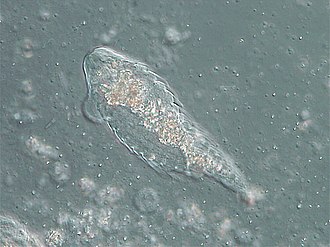Difference between revisions of "AY Honors/Protozoa/Answer Key"
m |
|||
| Line 24: | Line 24: | ||
A flagellate is a cell or organism with one or more whip-like appendages called flagella. The word flagellate also describes a particular construction (or level of organization) characteristic of many prokaryotes and eukaryotes and their means of motion. | A flagellate is a cell or organism with one or more whip-like appendages called flagella. The word flagellate also describes a particular construction (or level of organization) characteristic of many prokaryotes and eukaryotes and their means of motion. | ||
| − | [[File:Hypermastigida.jpg|thumb|Hypermastigid]] | + | [[File:Hypermastigida.jpg|thumb|left|Hypermastigid]] |
{{clear}} | {{clear}} | ||
Revision as of 04:54, 6 January 2018
1. What are the main characteristics of protozoa that put them in the Protista kingdom? What are the similarities and differences in relation to other protists (algae)?
All protists are eukaryotic -- meaning they have a cell nucleus that stores their DNA -- single-celled organisms. Protists are often considered animal-like or plant-like because they behave similarly to multi-cellular organisms. Protozoa is another name for animal-like protists.
Like all protists, protozoa are single-celled organisms with a cell nucleus. Some have more than one nucleus. Protozoa are heterotrophs, which means they can not make their own food, but instead must ingest other organisms for energy. Most reproduce asexually through mitosis, which involves the splitting of their cell into two identical copies. Some reproduce through meiosis, which is sexual reproduction. Seven phyla -- subdivisions of a kingdom -- of protists are protozoa.
2. Be able to identify by pictures or photos five common protozoa, giving their scientific names.
3. Give the classification of protozoa, giving their distinctive characteristics and at least one example of each group and its importance.
Flagellata (flagellated)
A flagellate is a cell or organism with one or more whip-like appendages called flagella. The word flagellate also describes a particular construction (or level of organization) characteristic of many prokaryotes and eukaryotes and their means of motion.
Ciliophora (ciliated)
Amoeba (phagocytic)
Sporozoans (spore-forming)
4. What are pseudopods? What is their purpose?
A pseudopod is a temporary cytoplasm-filled projection of a eukaryotic cell membrane or a unicellular protist. Pseudopods may be used for motility, or for ingesting nutrients or other particulate matter.

